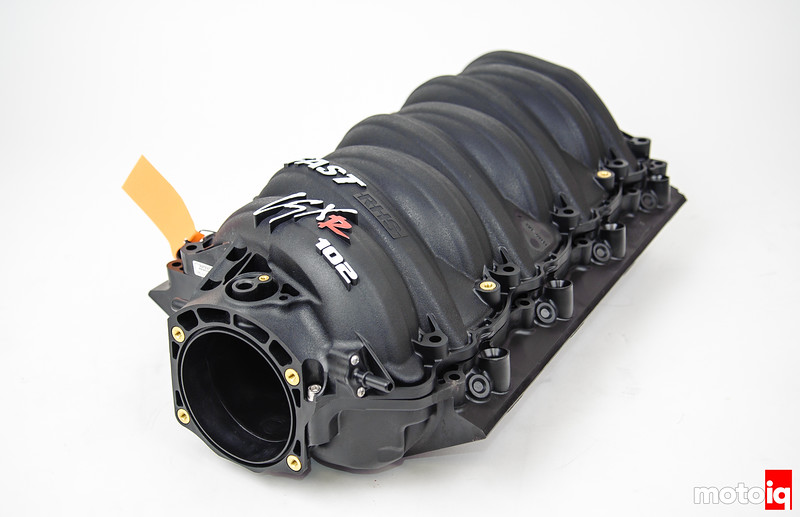
Valvetrain reliability is always an issue with drift cars. Drift cars are subjected to violent RPM change due to the tires spinning and hooking, clutch kicking and bouncing off the rev limiter. We have found that it is difficult to get valvetrain components to last in this environment even with good parts and conservative rev limits. To help cope with this extreme environment we enlisted the help of Comp Cams. Comp has recently come out with a grind especially suited for drifting and long duration events like road racing that has easier ramps that are designed to not excite the valvetrain with high order harmonics that can cause unpredictable valve surging in very dynamic conditions.
The new grind is part number 54-315-11 and it is a mechanical roller cam. We have found that hydraulic roller cars, even performance low lash ones to be unreliable in drifting as the rapid RPM fluctuations and harmonics cause them to pump up resulting in a loss of control of valve motion. Even with its gentile valve motion that sacrifices a little in the area under the lift curve, the cam still performs well, making up to 100 more hp over a stock cam.
The cam has pretty reasonable specs with 250 degrees of duration at 0.050″ lift on the intake and 260 degrees duration on the exhaust. The lift is 0.632″ on the intake and 0.629″ on the exhaust side. The lobe centers are 108 degrees on the intake and 114 degrees on the exhaust with a 111-degree lobe separation angle. These specs are good for a fuel injected, common plenum, naturally aspirated engine.
To compare, the stock LS3 cam has 204 degrees of intake duration and 211 degrees on the exhaust with 0.551″ intake lift and 0.525″ exhaust lift on a 117-degree lobe separation angle. This is way less lift, duration and a way more spread lobe angle for much less overlap. You can tell what was designed for low emissions and a smooth idle and what isn’t!

We used Comp’s solid mechanical roller lifters. These are solid with no hydraulic lash takeup. This means that the valve lash has to be periodically checked and adjusted. With solid lifters, there is no potential for pump up or float caused by the lifters not following the cam lobe accurately. That’s why they are used for racing applications. Having to adjust the valves as part of the car’s maintenance is the only drawback to solid mechanical lifters.

We used Comp Cams recommend dual valve springs. When putting together an engines valvetrain, it is usually advisable to use all of the parts recommended by the manufacturer of the cam. Often these parts are matched together to reduce high order harmonics that can contribute to valve float and damage. Valvetrain engineering these days is much more sophisticated than just upping the spring rate of the valve springs until the float stops!

We will also be using Comp Cam’s titanium retainers, machined billet keepers, spring seats and valve seals.

Comp Cams provided these 3/8″HI-TECH pushrods. The pushrods are made of centerless ground 0.080 wall thickness seamless chromoly tubing in one piece. The ends are formed on, not pressed or welded with extra thickness at the ends for strength. The pushrods are heat treated for guide plate compatibility.




7 comments
Do you think using thermal paste (ala CPUs) would help increase heat transfer on the main bearings?
Might aid in bearing spinning. Usually, engine builders advocate a tight fit on the main saddle for best heat transfer.
it won’t one bit: It will just desolve in oil. Let alone the chunks that get stuck at the oil pickup or the bearings. It just will not work if you really want to remove heat: Graphite paper. Bit that will nog keep the bearing in place. A graphite-silicon based sealer will most likely transfer heat a little less, but will be more resillient to spinning bearings.
Then again: Bearings normally won’t spin that much, unless there are either opposing forces ( flat 4’s for instance) or when the stroke gets to large compaired to the connecting rod. It isn’t so much extra power as it is the rod stroke length.
Mike – any thoughts on using a stock 4.8 crank to reduce the stroke and increase the rod length?
For a road racing or circle track car sure. A drift car needs grunt so I don’t think I would ever destroke one. Mange rod ratio, yes but not destroke. For Dai Yoshihara’s engines, I run a big 4.250 stroke for grunt but also run a super long 6.350 rod with a tall deck block. This gives a stroke to rod length ratio of 1.494:1 which is within the realm of OEM production engines yet still packs a bunch of displacement into a small package. One of our older blocks with a big bore gives us 477 cubic inches!
Mike – What is the best roller rocker / shaft roller rocker option for a stock ls3 head?
For drifting with lower rpm, probably Crower.